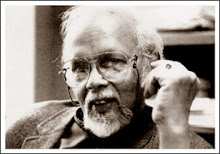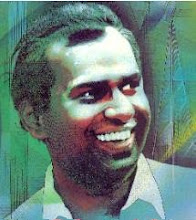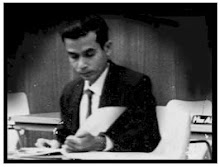Source: Sunday Observer
Date: 23/Aug/2009
Although the beginning of theatre can be traced back to the very beginning of the civilisation, the origin of folk theatre and dramatics can be traced to the ritualism of Vedic people of the second millennium BC. The rudiment of folk theatre consisted of dance, food, ritualism and depiction of events of the daily life. It was this depiction of events of the daily life which subsequently led to the birth of classical theatre.
Like the Peotics of Aristotle, it is the Natya Shastra of Bharata Muni which greatly influenced the Asian theatre. It was Natya Shastra which for the first time laid a firm technical foundation for drama. Extremely wide in scope, Natya Shastra describes in minutest details not only the precepts for the playwrights and actors but also ten types of drama, principles for stage design, make up, costume dance ( diverse movements and gestures) and a theory of aesthetics (Sasas and bhavas).
According to Bharata Muni, bhavas are the emulation of emotions that actors perform while the rasas (emotional responses) are those that inspire the audience. He lays down eight principle rasas; love, pity, anger, disgust, heroism, awe, terror and comedy. He points out that a play should be made up of diverse rasas but a principle rasa should dominate the play and all modes of expressions of an actor such as speech, gestures, movements and intonations should be used in a play.
However, the epics that first emerged from India were The Ramayana and Mahabharata which inspired generations of playwrights and still influence the work of art. Noh, Bunraku and Kabuki make up of Japanese theatre. Modern European theatre was dominated by realism. However, subsequently the tradition of realism was challenged and young dramatists experimented with theatre leading to the birth of host of new traditions such as epic theatre, absurdist theatre, and postmodern theatre. The landscape of twentieth century theatre was dominated by aesthetic movements such as Naturalism, Realism, Dadaism, Expressionism, Surrealism, Absurdism, Postmodernism as well as principal playwrights including Luigi Pirandello, Bertolt Brecht, Antonin Artaud, Konstantin Stanislavski, Harold Pinter, Eugene O'Neill, Samuel Beckett, Dario Fo and Tony Kushner.
Sri Lankan theatre
Early Sri Lankan theatre was greatly influenced by Indian theatre and drama.
Nadagam, a form of folk dance from India can be considered as the rudimentary form of Sinhala theatre. The next important phase of Sinhala theatre was the Tower Hall era which was dominated by early form of Sinhala drama referred to as 'nurthi'. The principal dramatists who dominated the landscape of theatre at the time were C. Don Bastian, W. John Perera, E.Y Perera, D. Bartholamus and John de Silva. Though John de Silva came into the scene much later, he virtually dominated the era.
However, it was Prof. Ediriweera Sarachchandra who converted rudimentary form of Nadagam into Proscenium stage with his seminal productions Maname and Singha Bahu. Prof. Sarachchandra, who was a scholar of international repute, was not only influenced by Western Classical theatre but also by Japanese traditional drama such as Noh and Kabuki. It was in 1959 with the regime change that Sarachchandra made Maname.
Maname and Sinha Bahu marked a watershed in Sinhala theatre. They are not only masterpieces in theatre but also prominent in the use of refined language, local idiom and techniques of theatre. For the first time, English medium theatre critics of the time, acknowledged the higher quality of the production.
One of the prominent characteristics of Sinhala theatre, from its very inception, was that the productions were influenced by the socio-cultural dynamics and the milieu in which the dramatists lived. While John de Silva's plays were intended to instil patriotism in the population, Sugathapala de Silva's plays were critical of the establishment. Sugathapala de Silva was greatly influenced by ideology of the leftist politics in general and Marxism in particular.
Sri Lankan tradition of ballet, though grew outside the mainstream theatre, has been moulded under the larger-than-life shadow of Chitrasena. It was the seminal productions of Chitrasena such as Nala Damayanthi and Karadiya which formed the anatomy of Sri Lankan ballet. The Chitrasena School which Chitrasena and his wife Vajira founded has produced generation of theatre personalities such as Ravibandu Vidyapathi and Channa Wijewardene. Perhaps, the singular contribution of Chitrasena to Sri Lankan theatre and drama was the adaptation of dying traditions such as Up Country, Low Country and Sabaragamuwa dance into proscenium stage and thereby preserving the corpus of indigenous knowledge associated with these traditions.
Gangsterism in theatre
With the socio-cultural transformation from feudalism to capitalism, the economic base for lineage-based school of tradition such as Garanas (generation of teachers by lineage) and traditional teachers of dance was eroded to a greater extent.
India which is home to a divergent group of such traditions and Garanas, has absorbed effectively the traditional form of art into its flourishing system of university. One of the benefits of institutionalisation of lineage-based schools of traditions is that the ability to tap a vast pool of talents from diverse parts of the country. It is an undeniable fact that informal sector, such as so-called academies of dancing have ganged up to project themselves as the saviours of traditions while distorting the image of the university. For instance, some theatre personalities, beyond doubt they are talented, are refusing even to visit the university, have sought media sponsorship from cheap media institutions for their performances.
The attitudes of some of the theatre personalities are anachronistic and out of touch with the reality. For instance, how can one be cultured if one serves one's teacher with a plastic cup of inferior quality while serving themselves with porcelain cups. The act smacks of class prejudices and is in the first place inhuman.
Gangsterism has denied stage for university graduates to perform. These so-called academies of dancing have virtually denied access of cultural units of diverse countries based in Colombo to university by tarnishing the name of the university.
Though there is absolutely nothing wrong in sponsoring academies of dancing, if the cultural unities intend recognising talents and tapping the growing talent base in universities, it is imperative to sponsor and aid the activities of the universities.




































No comments:
Post a Comment